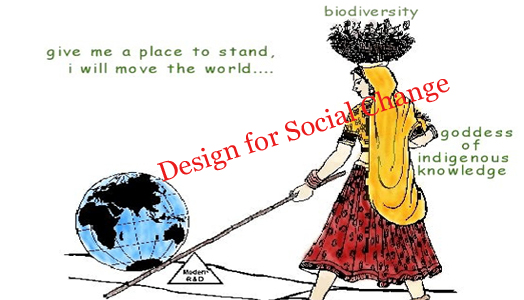IAnD Exclusive
Design Impact Special
By Prof. Anil Gupta
 |
| . |
In
an exclusive for India Art n Design ezine, Prof. Anil Gupta, as the Guest
Editor of our Design Impact Special Edition starting today, addresses this
pertinent issue that lies at the core of all design showbiz. If we need to use
Design for Social Change, will designers engage with grassroots innovators?
Prof.
Anil Gupta, known for his vast quantum of work with grassroots innovators via
the National Innovation Foundation and the Honey Bee Network, has seen, sifted,
helped implement several creative ideas that make for societal change. His
contribution to “design for society” is well represented through his Shodhyatra
– an exercise where he travels on foot into the interiors of India, scouting
for design talent at the grassroots level.
Initiating
the “Design Impact Week” at India Art n Design, Prof Anil Gupta nudges the
designers, the so-called thinkers and the creatives in society to wake up to
the social relevance of design and literally ‘do-something-about-it’. And he
gives us the platform – the Honey Bee Network. Over to Prof.:
Having
mobilized 180k ideas, innovations and traditional knowledge practices (of
course not all unique) from over 550 districts of the country, we should have
had by now tens of thousand ideas successfully diffusing among people needing
these solutions (see www.nifindia.org). The number of actual products that have gone
to market may be in thousands only (excluding exchanges in small
neighborhoods). If we add another about 200k
projects done by technology/engineering students (see www.techepdia.in, an initiative of
www.sristi.org), then the queue of ideas waiting to be taken forward becomes
even longer.
Assume
that only five to ten per cent of these are worth looking at by designers (at
least the awarded ones, (see techepdia.in/award), even then a long road exists
n which designers and grassroots innovators need to walk together hand in hand.
Community of lawyers working in the field of intellectual property protection,
have worked with us on pro bono basis
such that we could file more than 660 patents, majority in the last four years.
Can’t designer community too join hands with Honey Bee Network?
Designers should engage with society to
influence social imagination, its execution through frugal and aesthetically
functional and elegant rendering and to widen the community of users, who can
then fertilize the designers' repertoire.
As a teacher, I can say that one can never
teach authentically without learning. Designers should not see this engagement
as a do-gooding exercise. Instead, they should see it as a mutual learning
exercise. Elegance, excellence, equity and effectiveness can indeed be blended
with empathy, enterprise and education.
Designers, I have argued without any
doubt, are the weakest link in our innovation eco-system. They can make the
last mile journey of a product or service so much more effective. But if they
get involved from the beginning, they can make the whole supply chain more
effective and frugal. But they will have to learn to engage on new terms
such as design angels, design venture capitalists, design partners and design
donors. They can charge their full fee if the product is commercialized; they
can charge at concessional terms and they can also work as students of
community innovation academy. In the latter case, what they give is the fees
for learning at the feet of frugal, deviant and empathetic innovators at
grassroots.
Social change and impact will
accelerate manifold if designers meaningfully join hands with grassroots
innovators.
Look at the three examples harnessing waste heat of cooking stove and thus conserving energy from Arku valley, Mizoram and Meghalaya. Four shelves to cure wood rods used for trolleys, drying firewood in chirapoonji, preserving cheese or others food items and fumigating seed bag on the top in Meghalaya. Should not the design of our kitchen in cities change for ever?
Sheikh
Jahangir from Jalgaon made Three Idiots
famous through his innovation of scooter mounted flour grinding machine,
washing machine and many other ideas. But the products did not go to market
yet. Will you still place poor people at the bottom of pyramid, albeit economic
pyramid, or will you see their potential at the top of ethical and innovation pyramid
also?
Children are no less creative. Sometimes they can surpass our impatience with inefficiency faster and overcome inertia even faster. Look at the problem of using wrong posture sitting in front of TV or computer; who does not have lower back pain or some such problem once in awhile because of this? Did we do any thing at all except making doctors richer!
Children are no less creative. Sometimes they can surpass our impatience with inefficiency faster and overcome inertia even faster. Look at the problem of using wrong posture sitting in front of TV or computer; who does not have lower back pain or some such problem once in awhile because of this? Did we do any thing at all except making doctors richer!
Kulsoom
and Tarun have come out with excellent ideas, which were a great hit at an innovation
Exhibition held at Rashtrapati Bhavan ( March 7-13, 2014) organized by National
Innovation Foundation along with other sister institutions of Honey Bee
Network. Either a sensor screens your posture and switches off TV or unless you
sit properly, it will not switch it back on (patent applied). Or press buttons on the back will ensure
that you correct postures (P A). All of us were aware of the problem but we did
not do anything. But our children did not want to keep patient with inertia and
in that lay the hope for future. Will the designer community still remain
disconnected with Honey Bee Network?

.jpg)
.gif)
.gif)
.jpg)
.jpg)
.jpg)
.jpg)
No comments :
Post a Comment